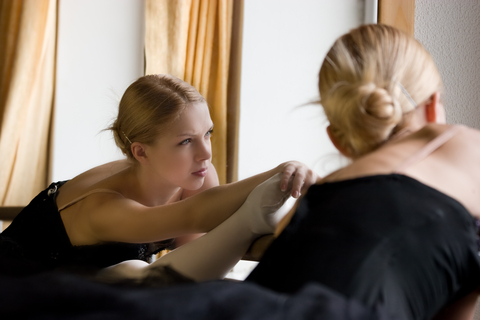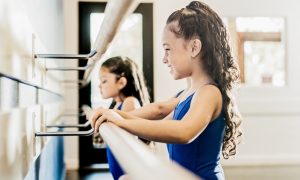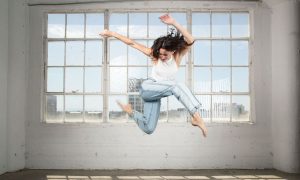By Emily Yewell Volin of Dance Informa.
Dance study trains more than the body, it influences every part of a person. These benefits apply to any student who studies dance, whether on a professional or recreational track. Consider these examples of how dance training helps develop crucial life skills:
Discipline & Etiquette
Practice leads to an artist’s personal best and steady progress is only possible when a student commits to completing a series of lessons under the guidance of a qualified instructor. Dance classes follow long-established protocols and syllabi for the proper training of the body. These protocols include matters such as dress code, tardiness, and expectations for how to address classmates and instructors alongside technical instruction goals. In turn the dancer develops the sense of respect for the process of hard work, earned goals, and a trained and professional instructor.
Organizational Skills
Dance training requires a person to be organized. Having the necessary shoes, hair, class uniform, and costumes for performances plus completing homework and other life events around a schedule of dance classes can be a struggle. A successful dancer must plan his/her short and long-term schedules and leave nothing to chance. Dancers are frequently the students who submit school assignments early because they can not risk having extra work during a performance week. The ability to prioritize and set short and long-term goals is a skill dancers keep for life. Dancers frequently see the ‘big picture’ and strategize ways to accomplish everything required. Any project can be viewed as a ‘production’ and dancers frequently see that process as linear and result-driven.
Responsiveness to Constructive Criticism
Dancers learn that growth requires constructive criticism from mentors and professionals in the field. Good instructors teach students that corrections are a teacher’s compliment and something to be desired. This ability to be coached is another asset to trained dancers. An instructor’s job is to be the technical coach with a trained artistic eye to help a student work toward accomplishing goals. This is a partnership and, in varying degrees, the instructor and student maintain a dialogue on how to best accomplish the next level of training. The coaching one receives during dance study and the dialogue it requires provides a positive model for teamwork and positive management.
Health
Dancers quickly learn the ramifications of either eating too much or too little, or simply the wrong thing for his/her body while dancing. Many associate their physical moods with the foods they use to fuel their bodies before they understand the nutritional science behind these fluctuations. Dancers learn what foods will properly fuel them while helping maintain a healthy level of fitness and learn their own requirements for sleep and rest. This introduction to basic nutrition, sleep requirements and physical fitness provide the starting point for a life-long interest in good health.
Presence
Dancers carry themselves in a unique way. They can always be spotted navigating a crowd or standing in a way that showcases their awareness of physicality. This is both postural and psychological. The dancer trains to become comfortable in his/her own stature and familiar with how articulations of the body speak volumes. When a dancer applies these skills to a non-dance environment he/she is often seen as statuesque, regal, and confident – all seen as positive traits in the work force.
Personal Style
Dancers frequently develop a personal style and typically rely less on popular culture’s influence about that style. It’s possible that all the time dancers spend training their artistic aesthetic makes them more adept at dressing-to-impress. It’s also possible that, as in costuming a performance, dancers enjoy costuming their days. Clothing, hair styles, and accessories become fun props and dancers are generally comfortable dabbling in a variety of looks based upon their current personae. These skills help a person stand out from a crowd and be a true original – this can be an entry point for becoming a leader.
Grooming and Basic Self Care
Dancers must be clean and well-groomed. They learn that while there is a time for experimentation in dress and appearance, there are also times when a uniform appearance is necessary. Hair buns and pink tights come to mind as possible conformity requirements that are in place for instructional purposes. Dancers learn to listen to their bodies’ aches and injuries and to responsibly handle them. The ability to discriminate between the time to be experimental and the time to rely on established decorum is essential to many professional situations.
Inventiveness
Dancers use creative thinking skills in every class and rehearsal. There is technical information going into their minds and being processed through their bodies. Simultaneously there is the need to artistically interpret the movement and to navigate through the space without accidental outcomes. These simultaneous processes require a dancer to sequence and plan. The rehearsal process demonstrates the editing process – something integral to the creative growth of any project or performance. That inventiveness is a key 21st century skill currently fueling educational and business practices.
World View
Dancers have many opportunities to become acquainted with other dancers from around the country and around the globe. Dance allows people of different cultures and customs to come together through training and performance opportunities. This also means there could be students taking class together who share the language of dance but no means of communicating in a shared spoken language. The ability to see others as a reflection of ourselves and to recognize our similarities instead of our differences goes a long way toward creating peaceful interactions outside the studio and theater.
Reflection
Dancers frequently thrive upon growth – technical, artistic, and personal. And, the dancers’ ability to reflect upon past strategies and outcomes allows them to continue progressing at a suitable pace. This ability to self motivate and regulate creates people with a tremendous capacity for vision and the skills to implement new ways of approaching old issues.
Photo (top): © Andriy Bezuglov | Dreamstime.com
















Pingback: Why you/your child should dance. | Baltimore School of Dance